
A Caveat
Protein Level in the Food
The most important variable when choosing a commercial dry food is the protein level. The higher the protein level in any food the healthier the fish. But this effect is NOT because eating high protein food is good for a fish. Rather the effect is due to what high protein food can do to the ecosystem that is in any aquarium. Higher protein food is a significant factor in creating crystal clear water. In turn, crystal clear water gives very healthy fish.
Note I personally simply buy the highest protein level I can find if I need to buy commercial pelleted fish food.
But it should also be noted that the BEST food is both homemade and Mazuri gel foods. Both of these are roughly 55% protein with very low carbohydrates. More information can be found in this article:
3.4. Homemade Gel Foods

Low protein food does not directly produce unhealthy fish. Rather its effect is indirect, through a long line of causal effects:
- A low protein food has a high carbohydrate content
- Carbohydrates are only 50% digested by the fish
- The undigested carbohydrates create dissolved organic compounds (DOCs) that have a high carbon to nitrogen ratio
- Pathogenic bacteria and other pathogenic organisms proliferate with high carbon to nitrogen ratio DOCs
- The proliferation of these organisms in the water column results in “dull” or even slightly milky water
- These pathogenic bacteria and other organisms in the water column attack the fish.
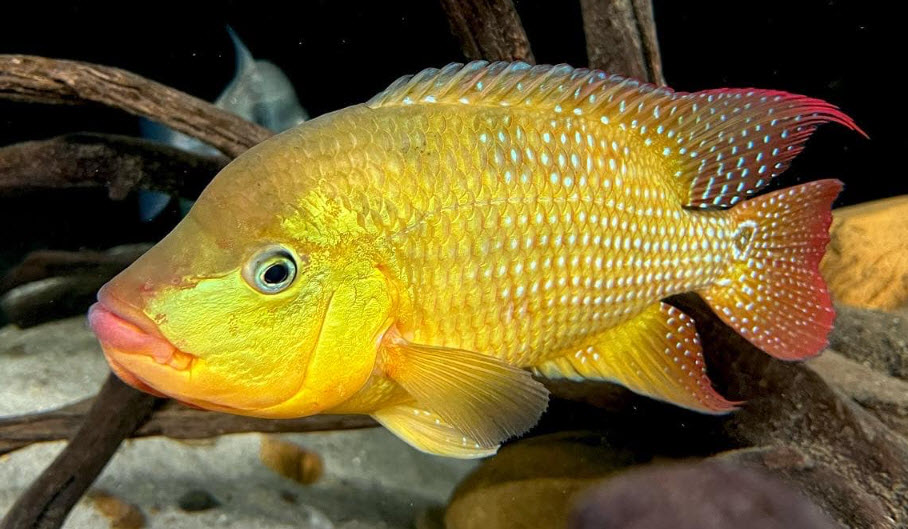
Now everyone wants to know what defines a low protein food. I make the cut-off at 45% for dry commercial fish food. But the “45% protein” level is completely arbitrary. In truth there is a continuum between 30% and 60%. A level of 42% protein in the dry commercial fish food won’t be “ideal” but it also won’t be that bad. The key is the clarity of the water. Is the 42% protein food giving crystal clear water? Or is it giving “dull” water or even slightly cloudy water. There is a “threshold” here.
But where the threshold will be is very dependent on a multitude of variables. For instance, 34% might give crystal clear water in one aquarium setup while 52% might give “dull” water in another aquarium setup. Note that if I must buy commercial fish food, I ALWAYS buy the highest protein level I can find.
Below I will discuss those food variables that directly affect the fish. This is with the clear understanding that all these effects are minor compared to the effect of the protein level on the health of the fish via the creation of a pathogen filled water column.
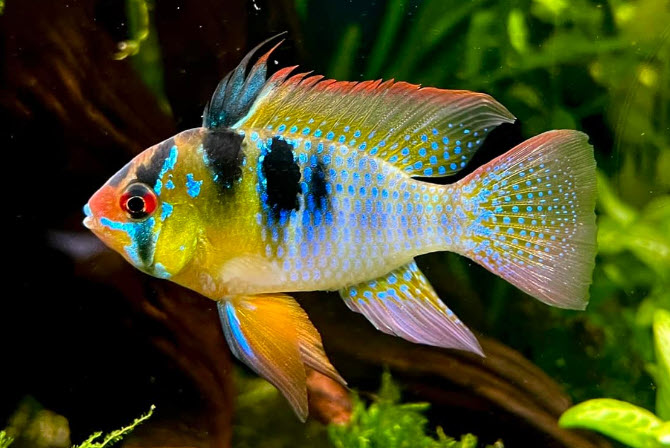
Commercial Fish Food Comparative Analysis
Now every fish owner wants his fish to be in the best health possible. But the bottom line is that food has little or no effect on the health or the longevity of aquarium fish. There are four slightly desirable characteristics only:
- For optimum juvenile growth rate, have over 40% protein
- For optimum fertility, have over 10% fat
- For optimum juvenile growth rate, have less than 30% cheap protein from the likes of soybeans
- For optimal juvenile growth, have the first few ingredients be some sort of whole fish or whole meat with ground bones in it, like fish meal, whole fish, or chicken leavings.
But it must be emphasized that this is all relative. Fish do just fine with food that is outside this range. All of the research found differences in the growth rate of juvenile fish and the fecundity of fish with foods at less than these levels. But the survival rates of the fish didn’t change with levels less than these “optimums”.

Here are some popular fish foods.
Here are some popular fish foods, rated by protein level. Obviously the Aquamax 500 is the best food.

This chart is based on the protein level of the food
- Green best >50% protein
- Yellow excellent 45-49% protein
- Orange good 40-44% protein
- Pink poor 35-39% Protein
- Blue bad 30-35% protein
- Purple bad >50% filler
In the section below this analysis is done for a total of thirty eight commercial fish foods and the math used is gone into depth.
3.6.1. Commercial Dry Fish Food in More Depth.
There have been many millions of dollars put into university research into the optimum food for growing commercial tilapia on farms. The profit motive can always be depended on to give the best course of action. In commercial aquaculture such as growing the cichlid fish tilapia, they use foods heavy with protein for actively growing fingerlings.
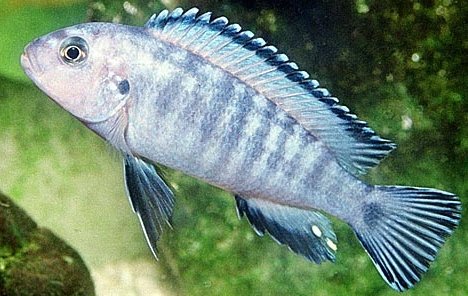
If one wants to feed their fish an inexpensive but high-quality dry commercial food one should buy Purina AquaMax 300 Tilapia Food over the internet. (available from Lakeway Tilapia for $4 per pound). This commercial fish food is based on millions of dollars of university research into the food requirements for fingerling tilapia cichlid fingerlings. You can’t beat the price. And Purina is answerable to the billion-dollar aquaculture industry. It’s very good food at a very good price.
Most aquarium owners feed their fish a lot of commercial dried food. Fish can thrive on virtually all commercial fish food, as millions of hobbyists can testify. The differences in the brands are small and probably completely immaterial.
Asking fish enthusiasts as to which their favorite food is like asking a redneck what their favorite pickup truck is: Ford, Chevy, or Dodge. Just depends on whose marketing hype is believed the most.
Now there are many “beliefs” when it comes to fish food. Some think the more items listed on the ingredients of a package the better the food. Others swear by probiotics. Still, others swear by such additives as vitamins and Omega 3 fatty acids. Still, others believe that “Just like us, fish like a varied diet”. Trying to change these beliefs is like throwing small pebbles at a brick wall. It’s a useless endeavor.
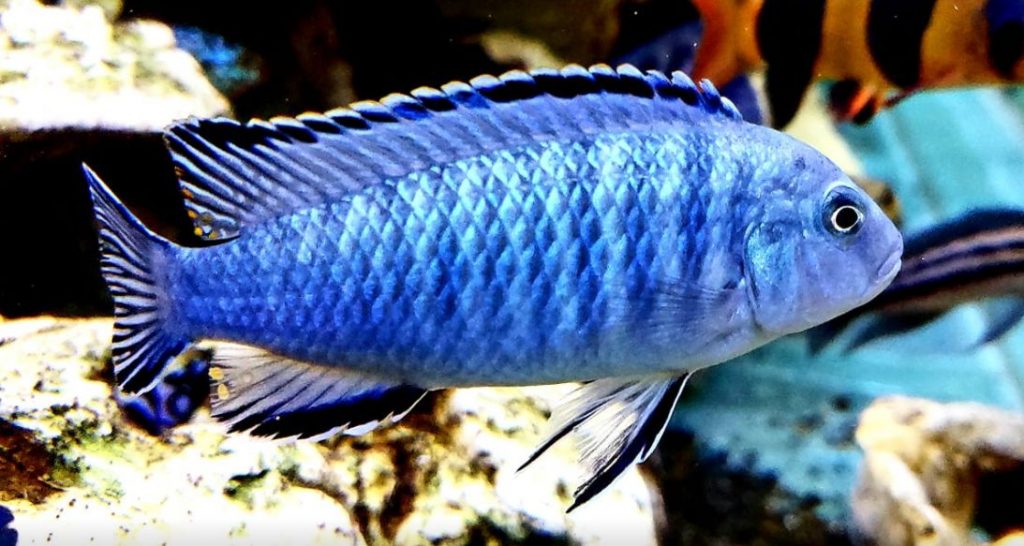
For many reasons, in the home aquarium, the types of food fed are very unimportant. Herbivores and carnivores do very well on just about any food. The reasoning behind this is delved into in more depth in this link:
3.1. Insignificance of Food
For those wanting more data on the many myths about fish food click on these links:
3.7. Banned Food
The myth of a correlation between high protein diets and Malawi Bloat is examined in this link:
3.8. Food and Malawi Bloat
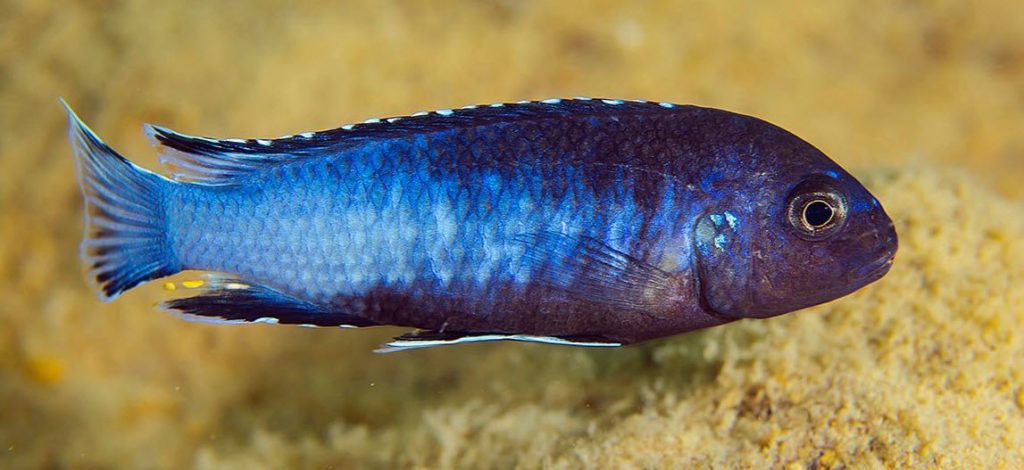
.
Return to Fish Food Menu
.
Aquarium Science Website
The chapters shown below or on the right side in maroon lead to close to 400 articles on all aspects of keeping a freshwater aquarium. These articles have NO links to profit-making sites and are thus unbiased in their recommendations, unlike all the for-profit sites you will find with Google. Bookmark and browse!
.

Luke B. says
Parrot fish, sorry, not puffer fish! Blood-red parrot cichlids.
Regards,
Luke B.
Luke B. says
Hello Dave,
I’ve found some commercial fish food that looks to be very high in protein and very low in carbohydrates – as per the information below:
“Ingredients:
Cereal and fish products, vegetable protein concentrate, dried haemoglobin, fodder yeast, animals fat, minerals and feed additives approved in the EU
The content of nutrient elements:
Crude protein – 63%,
crude fat – 15%,
fibre – 0,3%,
ash-11,6%,
water – 7
Vitamins:
A-13300 IE,
D3-2850 IE,
E -266IE
C-285 mg”
I’m setting up a new freshwater aquarium which’ll be stocked with either fancy gold fish or puffer fish. My current understanding is that puffer fish would do well with the the high protein, whereas the fancy gold fish might be more sensitive to it because “it could strain their kidneys”?
It’s apparently a ‘corporate’ food which to me implies RAS/fish farm use. The price is competitive at about half the price of branded food per 500g bag, and it comes in dimensions of 0.5 – 0.8mm and 1.2 – 1.5 mm.
Either way, I’m really curious to know what you make of it?
Best wishes (and happy Christmas),
Luke B.
Mark says
Ok, I tried them a couple years ago and the fish didn’t seem to eat them so I went back to bug bite flakes. I thought maybe I needed to soak them. It seems like the pellets would be easier to measure to make sure I don’t over feed.
Thanks, Mark
Dave says
In reply to Mark … Don’t soak the pellets.
Mark says
I have always feed flake food. I wanted to try the aqua max 300. Do pellets need to be soaked before I feed?
Thanks, Mark
Dave says
In reply to Long ..Fish resist switching foods. Just feed lightly till they start eating it
Long says
Hi Dave, thanks for your advice so far. That helps a lot. I’ll switch to the Matsuri gel once I feed up all the current ones. Just a question on the Purina Aquamax 300. It seems like my fish don’t like it at all. Most spit it out (esp. the angelfish). So should I keep feeding them that or switch to another one? They seem to like the Hikari products I had fed them before.
Dave says
In reply to Long …. Just put them in the fridge and they will last forever. But it should also be noted that the BEST food is both homemade and Matsuri gel foods. Both of these are roughly 55% protein with very low carbohydrates. More information can be found in this article:
3.4. Homemade Gel Foods https://aquariumscience.org/index.php/3-4-gel-fish-food/
Long says
Hi Dave, thanks for your reply so far. That helps a lot. Hope you don’t mind the many questions I’ve been asking. Just a practical question on Purina Aquamax 300. It seems to be the best food available but they are typically sold in bulk (at least 2-3 lbs). So do you know how long we can keep that before it goes bad? And is there any tips on preserving them as long as possible (like in a fridge)?